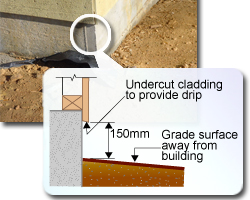Introduction
 Buildings clad with timber have many natural advantages on sites that are subject to high winds, extreme climate, highly reactive soils and subsidence or earth tremors. Timber's natural resilience and high strength-to-weight ratio enables it to withstand far greater stresses and movement than masonry or other rigid materials.
Buildings clad with timber have many natural advantages on sites that are subject to high winds, extreme climate, highly reactive soils and subsidence or earth tremors. Timber's natural resilience and high strength-to-weight ratio enables it to withstand far greater stresses and movement than masonry or other rigid materials.
Timber cladding performs best with wide eaves and verandahs. This provides weather protection to walls.
Cladding must be watertight with adequate flashing and sarking in accordance with best industry practice. Special care has to be taken with detailing and protection at ground level and north facing walls.
